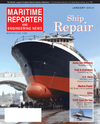
Page 31: of Maritime Reporter Magazine (January 2013)
Ship Repair & Conversion
Read this page in Pdf, Flash or Html5 edition of January 2013 Maritime Reporter Magazine
WWW.MARINELINK.COM 31plete propulsion load. The machinery system with compo-nents was full scale tested to meet the requirements of the U.S. Navy. Tests included thermal stability, vibration, full torque, full speed, 110% torque at 0 rpm, efÞ ciency, air bone noise, local and re- mote control, and for electromagnetic interference and shock testing. The combined electric/gas turbine sys-tems onboard were selected due to the U.S. Navy?s desire for a proven com- mercial off the shelf system that could be developed to meet critical Navy re-quirements and reduce cost. The select- ed machinery combination also greatly reduces the amount of time required to bring the ship?s engines online, improv- ing the ability to quickly get underway and respond to emerging threats or hu- manitarian crises. The ability to select the best combina-tion of power plants to match the im-mediate power requirements provides ß exibility in operation and reduction in operating costs. Amphibious assault ships spend approximately 75% of their underway time travelling at 12 knots or less. Therefore, Makin Island can use its electric auxiliary drive the majority of the time, saving fuel and reducing wear and tear, and related maintenance costs, on the ship?s primary engines. Interme- diate speeds of 15-16 knots were reached with best fuel economy by going with one gas turbine a little too fast, and then switching to only electric drives going 10-13 knots. According to NavSea, the crew size could be reduced by 80 to 90 engineering personnel. Beyond the environmental and energy- saving advantages of USS Makin Is-land?s propulsion system and all-electric auxiliaries design, the ship uses a stern ß ap to improve fuel economy, anti-foul- ing coatings to minimize hull drag, and solid state lighting to reduce energy use. The economic beneÞ t was quickly realized by operating the vessel on the APS instead of the greater fuel-consum-ing steam turbines. At a ship speed of 12 knots, the initial fuel savings on the trip from the shipyard in Pascagoula, to the vessel?s home port in San Diego, CA around the southern tip of South America, fuel savings of over $18,000/day were reached as compared to steam turbines powering the vessel and its electricity producing generators. The gas turbines are calculated to offer 12% fuel savings compared to a steam plant. The electric drive offers 30% fuel savings compared to gas turbines and 43% com-pared to a steam plant.The US Navy expects over the course of the ship?s lifecycle to see fuel savings of more than $250 million. ?As the Navy?s Þ rst operational test platform for this hybrid-electric propul-sion system, our fuel efÞ ciency directly enhanced the ability to operate forward for longer. Additionally, our signi Þ cant fuel cost savings, coupled with our les-sons learned, will serve as a solid foun-dation for optimizing this ship, as well as current and future ship designs,? said Capt. Cedric Pringle, Makin Island?s commanding ofÞ cer when the ship re- turned home from its Þ rst deployment. MR #1 (26-33).indd 31MR #1 (26-33).indd 311/2/2013 11:50:00 AM1/2/2013 11:50:00 AM

 30
30

 32
32
